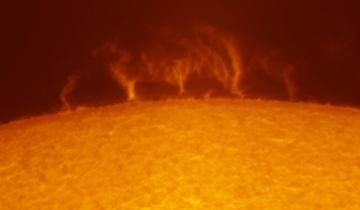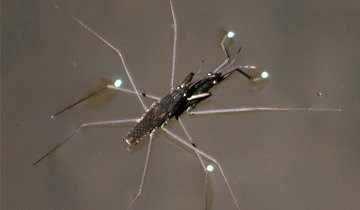 Where's Saturn? Is that a UFO--or the ISS? What's the name of that star? Get the answers from mySKY--a fun new astronomy helper from Meade. Where's Saturn? Is that a UFO--or the ISS? What's the name of that star? Get the answers from mySKY--a fun new astronomy helper from Meade. AURORA WATCH : Earth is entering a solar wind stream that could spark high latitude geomagnetic storms tonight. Sky watchers, be alert for auroras. MAGICAL PROMS: "As I watch the sun in motion, I see no-Rhyme, no-Reason in how the plasma behaves," says photographer Gary Palmer of Los Angeles, California. "One thing's for sure--it's magical." Regard this movie he made yesterday using his Coronado SolarMax90, and see if you agree: 
The 6.6 megabyte "IMAX" version of this movie is a must-see: click here.
The dancing arcs of plasma are prominences--arcs of hot gas held aloft by barely-stable solar magnetic fields. Each ragged loop is wide enough to fit a planet; Earth could roll through one with tens of thousands of kilometers to spare. Got a solar telescope? Take a look. These magical proms are still dancing today. more images: from Guenter Kleinschuster of Feldbach, Austria; from Franck Charlier of Marines, Val d'Oise - France; from Pavol Rapavy of Rimavska Sobota, Slovakia; from Robert Morlan of La Porte, Indiana. GERRIS ARGENTATUS: Photographer Mila Zinkova of San Francisco has found a new way to observe the sun--in the footprints of Water Striders: 
More images: #1, #2, #3
"Yesterday, I was on a bridge overlooking a pond when I noticed the sun reflected from dimples in the water where the Striders were standing," she says. Water Striders (the species pictured above is Gerris argentatus) weigh about 0.00002 lb, just enough to stretch the surface of the water without breaking through. The sides of the dimples act like tilted mirrors, beaming little images of the sun to observers around the pond. Strange but true: Each sun reflection lies near the core of an invisible vortex. A few years ago, researchers at MIT discovered that Water Striders use vortices as a means of propulsion. A drop of dye in the water reveals the hidden swirls.
.2007 Noctilucent Cloud Gallery
[Night-Sky Cameras] ["Noctilucent Cloud"--the song] | 
